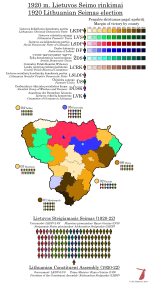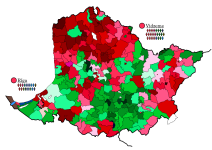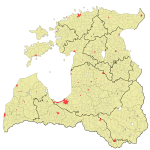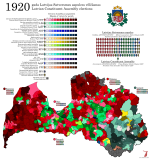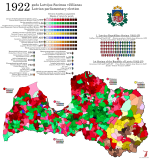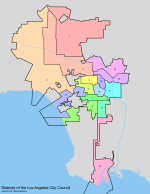Speaking of the Baltics, I finally found something I've spent a long time looking for. Unfortunately it's not as detailed as what I have for Estonia and Latvia, but some enterprising Wikipedian has in fact dug up a statistical yearbook that has all the Lithuanian election results up to 1926 (i.e. all the ones that mattered) broken down to
apskritis ("county") level.
Lithuania is quite different from the other Baltic states, and was even more so in the 1920s. Whereas Estonia and Latvia still carried the legacy of the Livonian Order, being largely Protestant countries dominated by a Baltic German landowning class, Lithuania had been in personal union with Poland until the partitions, and as a result was overwhelmingly Roman Catholic and had a native (albeit heavily Polonised) nobility that owned most of the land. It also had a very large Jewish minority, which Latvia did as well to an extent, and a long and complicated history with Prussia meant there was
some German influence as well, just not as heavy as it was in Estonia and Latvia.
Also, while Russia was generally content to let the Baltic Germans run free in Estonia and Latvia, Lithuania was subjected to some quite harsh Russification policies, including heavy restrictions on the Catholic Church and an outright ban on Lithuanian books written in the Latin script. These policies were intended to separate Lithuania from ever-rebellious Poland and tie it more closely to Russia, and Lithuanians very much saw them for what they were - Catholic priests and patriotic locals organised book smuggling rings which had books printed in East Prussia and taken across the border covertly, and were so successful that Lithuania got one of the highest literacy rates in the Russian Empire. In one sense, however, the printing ban was a success for Russia - the resistance to it did promote a sense of separate Lithuanian nationhood, and after 1905 the prevailing opinion even among the landowning class and the Catholic hierarchy was that Lithuania ought to be an independent state rather than part of a restored Polish-Lithuanian Commonwealth.
The views of these groups were most closely represented by the
Lithuanian Christian Democratic Party, which had been founded in 1890 to safeguard the Catholic Church but became more and more openly nationalist after the 1905 Revolution. The LKDP was very similar in orientation to the Polish
Endecja movement, supporting political Catholicism and a radical nationalism that tended to be directed against ethnic minorities within the country as much as outside forces. In the Lithuanian case, this especially meant Poles and Jews, both of which made up large parts of the population. When Lithuania became independent, the Catholic-nationalist movement established a number of side organisations, most prominent of which was the
Federation of Labour, which was a network of Catholic trade unions not unlike what existed in Germany at the same time. This helped draw urban workers into the fold of the movement, and a
Farmers' Association was set up to do the same for small farmers. The latter was even more closely tied to the LKDP, however, and the results I've found show them running a separate list only in the Kaunas and Raseiniai constituencies, winning seats only in the former. I noticed while writing this that parts of Wikipedia show them winning a total of 18 seats in this election, but I haven't found any information about where those were, so I've left the map as-is.
Very much like Poland, again, the opposition to the LKDP and its allies was heavily divided. The
Lithuanian Peasants' Union was closer to the PSL in ideology than it was to the farmers' parties in Estonia and Latvia, being generally centre-left and drawing support mostly from small farmers and landless farmworkers. The
Social Democratic Party had been a key part of the national revival, but found its electoral reach quite limited - especially compaed to its sister parties in the other Baltic states. There was also the
Socialist People's Democratic Party, which was a more conservative social democratic group that had been founded out of the former Lithuanian Democratic Party (which was also the originator of the Peasants' Union). Finally, of course, the ethnic minorities had their own organisations - the most prominent of these was the
Jewish Democratic Union (also called the Jewish National Union in some sources), founded for the 1920 election as an electoral alliance between the main Jewish groups operating in Lithuania.
The 1920 Constituent Assembly elections were the first democratic elections ever held in Lithuania, and were organised by the provisional government that had been formed under German occupation during World War I. The Assembly was intended to have 150 deputies elected from ten constituencies, but only six constituencies were actually able to hold elections. The remaining four - based in Vilnius, Lida, Grodno and Bialystok - were under the control of Józef Pilsudski's Polish army, which intended to restore the Commonwealth and rejected Lithuanian claims even to its historic capital as a result. Of course, Vilnius was overwhelmingly not ethnically Lithuanian (according to the 1897 census, its population was about equal parts Poles and Jews with Russians in third place and Lithuanians forming about 2-3% of the population), so we end up in the awkward position where the ethnic-nationalist Lithuanian government claimed it as a result of historic and cultural ties while the more pluralistic and expansionist Polish state cited its ethnic composition as a reason not to cede it. Poland would end up forming a "Republic of Central Lithuania" encompassing the city and its surroundings in late 1920, holding a pretty questionable election there in January 1922 and then annexing it into Poland directly.
The Constituent Assembly convened at the city theatre in Kaunas, the "temporary capital" designated in Vilnius' absence, in May 1920, and of the 112 deputies who were actually able to take their seats, 58 were affiliated with the Catholic movement - 10 with the Federation of Labour, either 3 or 18 with the Farmers' Association, and the remainder with the LKDP. This was enough to form a majority government, but the LKDP leadership still decided it was best to form a grand coalition, and invited LVS leader Kazys Grinius to form a government. LKDP stalwart Aleksandras Stulginskis was elected to chair the Assembly, however, which made him the
de facto head of state until a constitution could be written.
